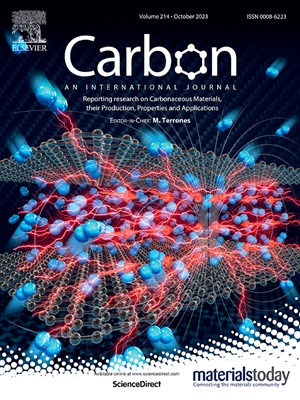用幂律粘度模型研究碳纳米管纤维湿法纺丝中的剪切稀化行为
IF 10.5
2区 材料科学
Q1 CHEMISTRY, PHYSICAL
引用次数: 0
摘要
本文章由计算机程序翻译,如有差异,请以英文原文为准。
Investigation into shear-thinning behavior in wet spinning of carbon nanotube fibers modeled by power law viscosity model
The wet spinning of carbon nanotube (CNT) fibers, a representative solution processing of CNTs, has been advanced through the integration of well-established polymer sciences into their field. However, the flow behavior of CNT dispersions in the narrow spinning line, where its characteristics undergo changes due to the high-shear rate regime, has not been utilized to determine their spinnability, despite being a commonly employed method in the wet spinning of polymer fibers. Herein, we employed the power law viscosity model to investigate the correlation between flow behavior and the spinnability of CNT dispersion through the power law index which approaches to 0 as the shear-thinning behavior strengthens. We suggest that the spinnability of CNT dispersion is proportional to the degree of shear-thinning behavior of the dispersion. We ascribe this correlation to the integrity of CNT fibers which predominantly rely on the strong van der Waals forces between CNTs. These findings offer new insights into the role of fiber integrity in spinnability and provide a framework for optimizing the wet spinning process of CNT fibers through detailed analysis of dispersion flow behavior.
求助全文
通过发布文献求助,成功后即可免费获取论文全文。
去求助
来源期刊

Carbon
工程技术-材料科学:综合
CiteScore
20.80
自引率
7.30%
发文量
0
审稿时长
23 days
期刊介绍:
The journal Carbon is an international multidisciplinary forum for communicating scientific advances in the field of carbon materials. It reports new findings related to the formation, structure, properties, behaviors, and technological applications of carbons. Carbons are a broad class of ordered or disordered solid phases composed primarily of elemental carbon, including but not limited to carbon black, carbon fibers and filaments, carbon nanotubes, diamond and diamond-like carbon, fullerenes, glassy carbon, graphite, graphene, graphene-oxide, porous carbons, pyrolytic carbon, and other sp2 and non-sp2 hybridized carbon systems. Carbon is the companion title to the open access journal Carbon Trends. Relevant application areas for carbon materials include biology and medicine, catalysis, electronic, optoelectronic, spintronic, high-frequency, and photonic devices, energy storage and conversion systems, environmental applications and water treatment, smart materials and systems, and structural and thermal applications.
 求助内容:
求助内容: 应助结果提醒方式:
应助结果提醒方式:


